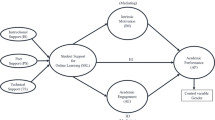Abstract
Massive Open Online Courses (MOOCs) potentially challenge the traditional dominance of brick and mortar institutions as providers of quality higher education. The benefits for students include reduced education costs and global access to exclusive institution courses and instructors. However, the benefits for institutions are less clear as there is a financial overhead required to develop and deliver content that is suitable for mass student consumption. In this article we examine the opportunities that MOOCs provide and identify several different business model challenges for offering MOOCs.
Similar content being viewed by others
Notes
In North American usage, this term is to be understood as “graduate.”
References
Asterhan, C. S. C. (2011). Assessing e-moderation behavior from synchronous discussion protocols with a multi-dimensional methodology. Computers in Human Behavior, 27, 449–458.
Attis, D., Koproske, C., & Miller, C. (2012). Understanding the MOOC trend: The adoption and impact of massive open online courses. Washington, DC: The Education Advisory Board. Retrieved from http://www.eab.com
Belanger, Y., & Thornton, J. (2013). Bioelectricity: A quantitative approach. Duke University’s first MOOC. Durham, NC: Duke University. Retrieved from http://hdl.handle.net/10161/6216
Blatter, M., Muehlemann, S., & Schenker, S. (2012). The costs of hiring skilled workers. European Economic Review, 56, 20–35.
Bruff, D. (2013, February 19). Online learning ecosystems: What to make of MOOC dropout rates? [Blog message]. Retrieved from http://derekbruff.org
Carey, K. (2013, February 13). Obama, Rubio agree on one thing: Technology could fix the Higher Ed mess. Slate. Retrieved from http://www.slate.com
Colman, D. (2013, April 2). The big problem for MOOCs visualized. Open Culture. Retrieved from http://www.openculture.com
Davidson, C. (2013, November 6). Clearing up some myths about MOOCs [Blog message]. Retrieved from Humanities, Arts, Science and Technology Alliance and Collaboratory (HASTAC) website http://www.hastac.org
EDUCAUSE (2012, December 20). What campus leaders need to know about MOOCs: an EDUCAUSE executive briefing. Louisville, CO: EDUCAUSE Publications. Retrieved from http://www.educause.edu
Edwards, C. (2012, August). MOOC’s: An analysis for BCIT. British Columbia, Canada: British Columbia Institute of Technology. Retrieved from http://landing.athabascau.ca
EvoLLLution NewsWire (2013). Finally, a business model for MOOCs. EvoLLLution. Retrieved from http://www.evolllution.com
Firmin, R., Schiorring, E., Whitmer, J., Willett, T., & Sujitparapitaya, S. (2013, September). Preliminary Summary: SJSU + Augmented Online Learning Environment: Pilot Project. San Jose, CA: Research and Planning Group for California Community Colleges. Retrieved from http://www.sjsu.edu
Gallagher, S., & Garrett, G. (2013, July 31). Disruptive education: Technology Enabled Universities. Sydney, Australia: United States Studies Centre, University of Sydney. Retrieved from http://ussc.edu.au
Haggard, S. (2013). The maturing of the MOOC (BIS Research paper number 130). London, England: Department for Business, Innovation and Skills. Retrieved from http://www.gov.uk
Higher Education Price Index (2013). Retrieved from the Commonfund Institute website: http://www.commonfund.org
Hyman, P. (2013, October 22). MOOCs evolve; Version 2.0 aims to retain more students. Communications of the ACM. Retrieved from http://cacm.acm.org
Jordan, K. (n.d.). MOOC Completion Rates: The Data [Table]. Retrieved from http://www.katyjordan.com
Kedem, K., & Puchalla, J. E. (2012). Shifting ground: Technology begins to alter centuries-old business model for universities. (Report Number 144483), New York, NY: Moody’s Investors Service. Retrieved from http://www.moodys.com
Kolowich, S. (2012a, June 11). How will MOOCs make money? Inside Higher Ed. Retrieved from http://www.insidehighered.com
Kolowich, S. (2012b, September 12). The MOOC Survivors. Inside Higher Ed. Retrieved from http://www.insidehighered.com/
Kolowich, S., (2013a, February 21). How EdX plans to earn, and share, revenue from its free online courses. The Chronicle of Higher Education, Retrieved from http://www.chronicle.com
Kolowich, S., (2013b, March 24). The Professors Who Make the MOOCs. The Chronicle of Higher Education. Retrieved from http://www.chronicle.com
Leckart, S., (2012, March 20). The Stanford education experiment could change higher learning forever. Wired. Retrieved from http://www.wired.com
Lewin, T., (2013, January 6). Students rush to web classes, but profits may be much later. The New York Times. Retrieved from http://www.nytimes.com
Loukis, E., Pazalos, K., & Salagara, A. (2012). Transforming e-services evaluation data into business analytics using value models. Electronic Commerce Research and Applications, 11, 129–141.
Morris, L. V. (2013). MOOCs, emerging technologies, and quality. Innovative Higher Education, 38, 251–252.
Rivard, R., (2013a, March 22). Coursera’s contractual elitism. Inside Higher Ed. Retrieved from http://www.insidehighered.com
Rivard, R. (2013b, July 18). Udacity project on “pause”. Inside Higher Ed. Retrieved from http://www.insidehighered.com
Sandeen, C. (2013, July 18). From hype to nuanced promise: American higher education and the MOOC 3.0 era. The Huffington Post. Retrieved from http://www.huffingtonpost.com
Sitzmann, T. (2012). A theoretical model and analysis of the effect of self-regulation on attrition from voluntary online training. Learning and Individual Differences, 22, 46–54.
Young, J. R. (2012a, July 19). Inside the Coursera contract: How an upstart company might profit from free courses. The Chronicle of Higher Education. Retrieved from http://www.chronicle.com
Young, J. R., (2012b, July 19). The U. of Michigan's contract with Coursera. The Chronicle of Higher Education. Retrieved from http://www.chronicle.com
Young, J. R. (2013, February 21). Revenue-sharing models between edX and university partners. The Chronicle of Higher Education. Retrieved from http://www.chronicle.com
Yuan, L., & Powell, S. (2013). MOOCs and open education: Implications for higher education (2013:WP01). Bolton, UK: JISC Centre for Educational Technology & Interoperability Standards. Retrieved from http://www.cetis.ac.uk
Author information
Authors and Affiliations
Corresponding author
Rights and permissions
About this article
Cite this article
Burd, E.L., Smith, S.P. & Reisman, S. Exploring Business Models for MOOCs in Higher Education. Innov High Educ 40, 37–49 (2015). https://doi.org/10.1007/s10755-014-9297-0
Published:
Issue Date:
DOI: https://doi.org/10.1007/s10755-014-9297-0




